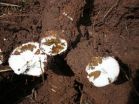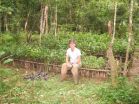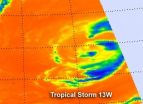(Press-News.org) ST. LOUIS, MO, August 7, 2012— An international research collaboration recently demonstrated progress in protecting cassava against cassava brown streak disease (CBSD), a serious virus disease, in a confined field trial in Uganda using an RNA interference technology. The field trial was planted in November 2010 following approval by the National Biosafety Committee of Uganda. The plants were harvested in November 2011 and results were published in the August 1, 2012 issue of the journal Molecular Plant Pathology . These results point researchers in the right direction as they develop virus-resistant cassava varieties preferred by farmers in Eastern Africa.
In Sub-Saharan Africa, more than 250 million people derive at least 25 percent of their daily calorie intake from the starchy cassava tuberous roots. In the East African countries of Uganda, Kenya, Tanzania, Mozambique, Rwanda, Burundi and Malawi, 63 percent of households also sell cassava products to earn income for their families. It is estimated that in the next 15 years, cassava will constitute the second most important source of income for more than 125 million people in East Africa.
Cassava brown streak disease is a major problem because it destroys the edible tuberous roots, but visual symptoms on leaves and stems are sometimes difficult to detect. This means unexpected losses for farmers at harvest, with potential devastating impact on families that depend on cassava for food security. Since farmers preserve cassava cuttings in the fields for the next crop, the disease is passed on to the next growing season. Around the Lake Victoria region in Uganda, where an epidemic of the disease is rapidly spreading, many farmers have been forced to abandon the cultivation of cassava. The urgency posed by this disease demands that appropriate tools be employed and interventions applied to solve the problem.
Researchers at the Donald Danforth Plant Science Center and two partner institutions in Africa, the National Crops Resources Research Institute in Uganda (NaCRRI) and the Kenya Agricultural Research Institute (KARI), are working to solve the problem for African farmers through a collaborative project called Virus Resistant Cassava for Africa (VIRCA). The VIRCA project has been developing cassava with enhanced resistance to cassava brown streak disease (CBSD) and cassava mosaic disease (CMD).
"The collaboration is showing progress toward helping smallholder farmers combat these devastating diseases," said Dr. Anton Bua, the Ugandan Cassava Research Team Leader in charge of field trials and communication for the project in East Africa.
"In Uganda, we eat cassava two or three times per day. Restoring and improving cassava productivity will be critical to the continued economic progress of the country and the region," said Dr. Titus Alicai, project lead, National Crop Resources Research Institute (NaCRRI).
Experts with the UN Food and Agriculture Organization (FAO) have expressed concern that CBSD is on the verge of becoming an epidemic in parts of Africa. A press release issued by the FAO last November called for an urgent increase in funding, research, training, surveillance and other measures to help African farmers and breeders. The concern is strong because cassava contributes to household incomes and food security more than any other single crop in some countries.
INFORMATION:
VIRCA is supported by the Bill & Melinda Gates Foundation, the Howard Buffett Foundation, the Monsanto Fund and USAID from the American People.
About The Donald Danforth Plant Science Center
Founded in 1998, the Donald Danforth Plant Science Center is a not-for-profit research institute with a mission to improve the human condition through plant science. Research at the Danforth Center will feed the hungry and improve human health, preserve and renew the environment, and enhance the St. Louis region and Missouri as a world center for plant science. The Center's work is funded through competitive grants and contract revenue from many sources, including the National Institutes of Health, U.S. Department of Energy, National Science Foundation, U.S. Department of Agriculture, U.S. Agency for International Development, the Bill & Melinda Gates Foundation and Howard G. Buffett Foundation.
The Donald Danforth Plant Science Center invites you to visit its website, www.danforthcenter.org, featuring interactive information on the Center scientists, news, education outreach and "Roots & Shoots" blog help keep visitors up to date with Center's current operations and areas of research.
Researchers demonstrate control of devastating cassava virus in Africa
International partnership makes progress to develop product for African farmers
2012-08-08
ELSE PRESS RELEASES FROM THIS DATE:
GEN reports on recent progress in Alzheimer's research
2012-08-08
New Rochelle, NY, August 7, 2012—The global market value of Alzheimer's disease therapeutics could soar to the $8 billion range once therapeutics are approved that actually change the course of the disease, reports Genetic Engineering & Biotechnology News (GEN). The current therapeutic market is valued at $3 to $4 billion, shared among drugs that temporarily delay disease progression or address the symptoms but do not alter the underlying disease, according to a recent issue of GEN.
"Despite all the research on amyloid plaques and neurofibrillary tangles there is still ...
Notre Dame researcher is shedding light on how jaws evolve
2012-08-08
If you're looking for information on the evolution and function of jaws, University of Notre Dame researcher Matt Ravosa is your man.
His integrative research program investigates major adaptive and morphological transformations in the mammalian musculoskeletal system during development and across higher-level groups. In mammals, the greater diversification and increasingly central role of the chewing complex in food procurement and processing has drawn considerable attention to the biomechanics and evolution of this system. Being among the most highly mineralized, and ...
Can nature parks save biodiversity?
2012-08-08
The 14 years of wildlife studies in and around Madagascar's Ranomafana National Park by Sarah Karpanty, associate professor of wildlife conservation at Virginia Tech's College of Natural Resources and Environment, and her students are summarily part of a paper on biodiversity published July 25 by Nature's Advanced Online Publication and coming out soon in print.
As human activities put increasing pressures on natural systems and wildlife to survive, 200 scientists around the world carved up pieces of the puzzle to present a clearer picture of reality and find ways to mitigate ...
Planting the seeds of defense
2012-08-08
LA JOLLA, CA----It was long thought that methylation, a crucial part of normal organism development, was a static modification of DNA that could not be altered by environmental conditions. New findings by researchers at the Salk Institute for Biological Studies, however, suggest that the DNA of organisms exposed to stress undergo changes in DNA methylation patterns that alter how genes are regulated.
The scientists found that exposure to a pathogenic bacteria caused widespread changes in a plant's epigenetic code, an extra layer of biochemical instructions in DNA that ...
Increasing federal match funds for states boosts enrollment of kids in health-care programs
2012-08-08
Ann Arbor, Mich. — Significantly more children get health insurance coverage after increases in federal matching funds to states for Medicaid and the Children's Health Insurance Program (CHIP), according to new research from the University of Michigan.
The research, published Monday in the journal Health Affairs, showed that a 10-percentage-point increase in the federal match for Medicaid and CHIP, similar to the increase that occurred with the American Reinvestment and Recovery Act, is associated with an increase of 1.9 percent in the number of children enrolled in ...
Infrared NASA imagery shows a weaker Tropical Storm 13W
2012-08-08
Infrared satellite imagery from shows how cold cloud top temperatures are in a tropical cyclone, and recent imagery from NASA's Aqua satellite shows the cloud-top temperatures have been warming in Tropical Storm 13W. Warming cloud top temperatures indicate less strength, and Tropical Storm 13W is weakening.
NASA's Aqua satellite passed over Tropical Storm 13W on August 7 at 0253 UTC. The Atmospheric Infrared Sounder (AIRS) instrument that flies onboard Aqua captured an infrared image of the storm's cloud temperatures that showed very limited strong thunderstorms make ...
NASA sees Tropical Storm Haikui closing in on China
2012-08-08
Tropical Storm Haikui is headed for landfall in southeastern China, and NASA's Aqua satellite caught a stunning image of its size and its ragged, but wide eye when it was a typhoon earlier today, August 7. As a result of interaction with land, Haikui has weakened to a tropical storm.
When NASA's Aqua satellite passed over Typhoon Haikui on August 6, 2012 at 12:35 a.m. EDT the Moderate Resolution Imaging Spectroradiometer (MODIS) instrument onboard captured an image of the storm as it was approaching China. The MODIS image clearly showed Haikui's ragged and elongated eye ...
NASA satellites revealed Tropical Storm Ernesto's strongest side
2012-08-08
Satellite data helps forecasters see where the strongest part of a tropical cyclone is located, and NASA's Aqua satellite noticed Ernesto's strongest storms were on the eastern side yesterday. Today, strong storms surround Ernesto's center.
A visible image of Tropical Storm Ernesto approaching Central America was captured by the Moderate Resolution Imaging Spectroradiometer (MODIS) instrument that flies onboard NASA's Aqua satellite. In an image captured on August 6, 2012 at 1840 UTC (2:40 p.m. EDT), the strongest thunderstorms appeared to be on the northern and eastern ...
COI declarations and off-label drug use
2012-08-08
Conflict-of-interest statements made by physicians and scientists in their medical journal articles after they had been allegedly paid by pharmaceutical manufacturers as part of off-label marketing programs are often inadequate, highlighting the deficiencies in relying on author candidness and the weaknesses in some journal practices in ensuring proper disclosure, according to a study by international researchers published in this week's PLOS Medicine. Off-label marketing is the promotion by a manufacturer of a drug for use in a condition or age group, or in a dose or form ...
NJIT scientist creates instrument for NASA Aug. 23 launch
2012-08-08
NJIT Distinguished Research Professor and former Bell Labs scientist Louis J. Lanzerotti, will see his 50-year quest to better understand space weather and Earth's Van Allen Radiation Belts rocket, once again, into space on Aug. 23, 2012. This is when NASA's twin Radiation Belt Storm Probes (RBSP) begin their mission to study the extremes of space weather. Lanzerotti, today one of the most respected and valued scientists behind space exploration, was the principal investigator to build one of five instruments aboard each of the two spacecraft that comprise the RBSP mission. ...
LAST 30 PRESS RELEASES:
New critique prompts correction of high-profile Yellowstone aspen study, highlighting challenges in measuring ecosystem response to wolf reintroduction
Stroke survivors miss critical treatment, face greater disability due to systemic transfer delays
Delayed stroke care linked to increased disability risk
Long term use of anti-acid drugs may not increase stomach cancer risk
Non-monetary 'honor-based' incentives linked to increased blood donations
Natural ovulation as effective as hormones before IVF embryo transfer
Major clinical trial provides definitive evidence of impacts of steroid treatment on severe brain infection
Low vitamin D levels shown to raise risk of hospitalization with potentially fatal respiratory tract infections by 33%
Diagnoses of major conditions failing to recover since the pandemic
Scientists solve 66 million-year-old mystery of how Earth’s greenhouse age ended
Red light therapy shows promise for protecting football players’ brains
Trees — not grass and other greenery — associated with lower heart disease risk in cities
Chemical Insights scientist receives Achievement Award from the Society of Toxicology
Breakthrough organic crystalline material repairs itself in extreme cold temperatures, unlocking new possibilities for space and deep-sea technologies
Scientists discover novel immune ‘traffic controller’ hijacked by virus
When tropical oceans were oxygen oases
Positive interactions dominate among marine microbes, six-year study reveals
Safeguarding the Winter Olympics-Paralympics against climate change
Most would recommend RSV immunizations for older and pregnant people
Donated blood has a shelf life. A new test tracks how it's aging
Stroke during pregnancy, postpartum associated with more illness, job status later
American Meteorological Society announces new executive director
People with “binge-watching addiction” are more likely to be lonely
Wild potato follows a path to domestication in the American Southwest
General climate advocacy ad campaign received more public engagement compared to more-tailored ad campaign promoting sustainable fashion
Medical LLMs may show real-world potential in identifying individuals with major depressive disorder using WhatsApp voice note recordings
Early translational study supports the role of high-dose inhaled nitric oxide as a potential antimicrobial therapy
AI can predict preemies’ path, Stanford Medicine-led study shows
A wild potato that changed the story of agriculture in the American Southwest
Cancer’s super-enhancers may set the map for DNA breaks and repair: A key clue to why tumors become aggressive and genetically unstable
[Press-News.org] Researchers demonstrate control of devastating cassava virus in AfricaInternational partnership makes progress to develop product for African farmers





